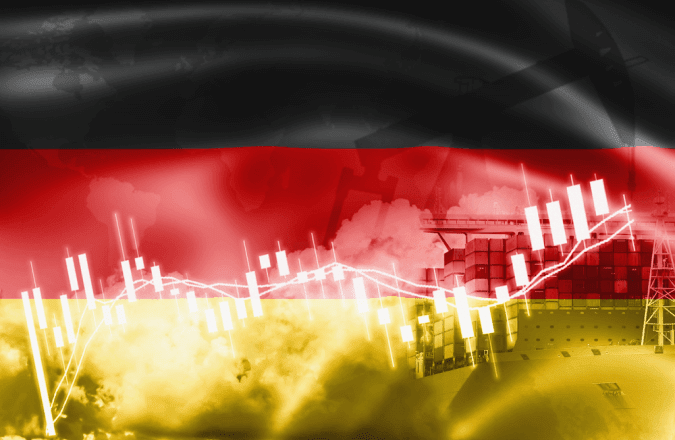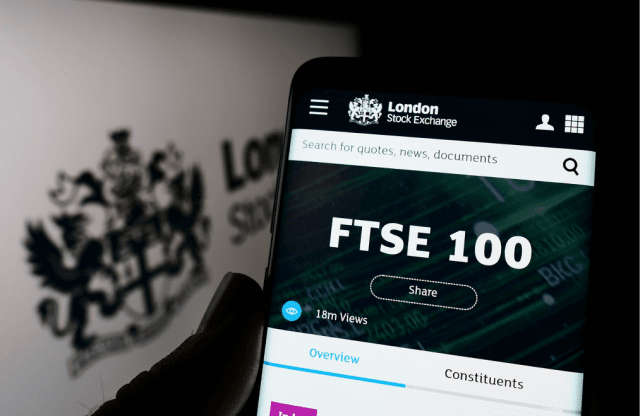A complete guide to trading the Germany 40 index

The Germany 40 index ranks some of Germany’s largest listed companies. Find out about its history, how it’s compiled, how to trade it with CFDs, and more.
What is the Germany 40?
The Germany 40 is a stock market index ranking the top 40 blue-chip companies listed on the Frankfurt Stock Exchange in Germany. As one of the most prominent stock indices in Europe, it’s seen as a benchmark for the performance of the German stock market and domestic economy in general. The Germany 40 index is calculated by Deutsche Börse.
The Germany 40 represents companies from various sectors, including automotive, pharmaceuticals, technology, and financial services, reflecting the overall health and performance of the German economy. The Germany 40 itself is a free-float market capitalisation-weighted index, meaning that the components are weighted by their market capitalisation adjusted for the number of shares available for trading. Companies with larger market caps have a greater influence on the index's performance.
The expansion from 30 listed companies to 40, which occurred in September 2021, aimed to provide a broader and more accurate representation of the German stock market. This change was part of a reform to improve the quality and resilience of the index.
What is the Germany 40 price history?
The Germany 30, as it was formerly, was introduced on 1 July 1988, with a base index value of 1000. During the 1990s, the index experienced significant growth due to the reunification of Germany and the subsequent economic boom, reaching a value of around 6000 by the end of the decade. Like other major indices, the dot-com bubble pushed the market higher, to over 8000 points in 2000. However, the bursting of the bubble led to a sharp decline, causing the index to fall to around 2200 by March 2003.
From 2003 to 2007, the index recovered strongly, driven by economic growth and corporate profits, climbing back to around 8000 by mid-2007. But the subsequent global financial crisis of 2008 caused a dramatic decline to around 3600 points by March 2009. The post-crisis period saw a steady recovery and growth, aided by low-interest rates and economic stimulus measures, with the index reaching an all-time high of over 12000 points in April 2015. Despite the European debt crisis causing volatility in 2011-2012, the index rebounded quickly.
In 2016, the Brexit vote introduced significant volatility, but the index maintained its upward trend. The index faced challenges in 2018 due to US-China trade tensions and global economic growth concerns, ending the year around 10600. But the Covid-19 pandemic in 2020 caused a sharp decline again, dropping the index to about 8400 in March. However, aggressive monetary and fiscal stimulus helped the index recover rapidly.
A significant change occurred in September 2021 when the index was expanded to the Germany 40, better representing the German economy. Despite challenges in 2022, including inflation concerns, supply chain disruptions, and geopolitical tensions from the Russia-Ukraine conflict, the index maintained overall strength. By mid-2023, as economic conditions improved, the Germany 40 hovered around 16000.
Today, the Germany 40 continues to be a vital indicator of Germany's economic health and a key benchmark for investors worldwide.
What factors might affect the performance of the Germany 40?
The performance of the Germany 40 may be impacted by a range of key fundamental events. Here are a few of the main factors:
- Economic indicators: the health of Germany's economy is reflected in the Germany 40 price. Economic indicators like GDP growth rates reveal the country’s economic progress, influencing investor sentiment and, consequently, share prices. Employment data acts as another barometer of economic health, with strong job growth signalling a robust economy and boosting market confidence. Similarly, consumer confidence measures how optimistic consumers feel about their financial situation and the state of the economy, affecting their spending behaviour and, indirectly, the stock market. Furthermore, as a major industrial powerhouse, Germany's industrial production levels offer insights into economic activity, with higher production levels generally leading to positive movements in the Germany 40 and vice versa.
- Monetary policy: monetary policies set by the European Central Bank (ECB), particularly interest-rate decisions, are significant levers affecting the index. Interest rates affect the cost of borrowing, impacting appetite for investments, the costs of servicing debt, and disposable income in the economy, factors which can in turn impact stock prices.
- Global economic conditions: since Germany is a major exporter, the Germany 40 is also influenced by global economic conditions. The economic performance of key trading partners like the US, China, or other European countries can impact the index. Global economic growth in general can drive up demand for German exports, positively influencing the Germany 40, while downturns can impact the spending power of citizens, causing a selloff. Find out more about the potential fundamental conditions that can hit indices by exploring our market analysis.
- Geopolitical events: trade tensions, conflicts, and political instability are examples of events that can cause market volatility and impact the Germany 40. Trade disputes between major economies can disrupt supply chains and affect the performance of multinational companies listed on the index. Additionally, political events like Brexit have shown significant impacts on European markets, including the Germany 40.
- Corporate performance: the performance of individual companies within the Germany 40 can significantly influence the overall index. Strong earnings reports, innovative product launches, and strategic mergers or acquisitions can boost investor confidence and drive up stock prices. Conversely, poor financial results, scandals, or management issues can lead to declines in the index.
- Currency fluctuations: the strength of the euro pairs such as EUR/USD can affect the Germany 40. A strong euro can make German exports more expensive and less competitive internationally, potentially hurting the profits of export-oriented companies. Conversely, a weaker euro can boost exports by making them cheaper on the global market, benefiting the index.
- Regulatory environment: changes in the regulatory environment, both within Germany and the European Union, can impact the Germany 40. Stricter regulations can increase compliance costs and limit business operations, while deregulation can create more favourable conditions for growth and investment.
What companies are in the Germany 40?
The Germany 40 boasts some global giants of commerce, such as enterprise software leader SAP, automotive titan Volkswagen, and the largest chemical producer in the world, BASF. Other notable companies are insurance conglomerate Allianz, sporting goods brand Adidas and telecoms provider Deutsche Telekom. Like other major indices, the composition is subject to change based on performance. Consequently, companies may enter and leave the index, and a reordering of constituents is commonplace.
What are the Germany 40 stock market hours?
The Germany 40 stock market hours are based on the hours of the Frankfurt Stock Exchange, which operates its regular trading session from 9:00am to 5:30pm CET, or 8:30am to 4:30pm UTC. For international traders looking to trade this market, it’s worth referring to the stock market hours page to see how the largest global exchanges align with the hours you’re trading.
If you choose to trade CFDs, you can follow the Germany 40 performance live with the comprehensive Germany 40 price chart.
Monitoring the index’s activity can help you to keep an eye out for any key fundamental or technical events that may affect short-term movements in the price.
How to trade the Germany 40 with CFDs
If you want to take a position on the Germany 40, you have a choice of methods. First, you can trade a derivative product such as a contract for difference (CFD) on the stock market price using leverage. A CFD is a financial contract, typically between a broker and a trader, where one party agrees to pay the other the difference in the value of a security, between the opening and closing of the trade.
Using a CFD, you can either hold a long position (speculating that the Germany 40 price will rise) or a short position (speculating that it will fall). This is considered a short-term investment or trade, as CFDs tend to be used within shorter timeframes.
CFDs are traded on margin, which means that a trader can get exposure to larger positions with a relatively small outlay. This amplifies the potential profits, but also the potential losses, making such trading risky. You can learn how to trade shares in our comprehensive guide to shares trading.
Aside from CFDs, you can also trade the Germany 40 through instruments like options, ETFs, and mutual funds. Options allow for speculative investment with controlled risk, ETFs enable straightforward stock-like trading of the index, and mutual funds offer a managed, buy-and-hold approach to tracking its performance. Each offers an alternative to the leveraged trading of CFDs, catering to different risk profiles and investment strategies.
To trade share CFDs with us, just sign up for a Capital.com account, and once you’re verified, you can use our advanced web platform or download our intuitive yet easy-to-use app. It’ll take just a few minutes to get started and access the world’s most-traded markets.
Need more support? Try our step-by-step indices course to guide you through the basics to the advanced concepts.
Why trade index CFDs with Capital.com?
Trading index CFDs with Capital.com means you’ll enjoy an intuitive, easy-to-use platform, 24/7 support, fair and transparent pricing, along with award-winning education to help build your experience in the markets.* You can seamlessly integrate our smart platform with elite third-party software TradingView and MT4, and refine your strategies with our risk-free demo.
*Awarded best-in-class for education at ForexBrokers.com’s 2024 Annual Awards
FAQs
Why is the Germany 40 important to traders?
The Germany 40 is a commonly-used index to document domestic performance, as it’s a bellwether for German economic trends. The index may rise when commercial prospects are promising, or fall during broader downturns, although the performance of indices can be complex and is not always linked to economic performance.
What affects Germany 40 prices?
The Germany 40 index, which represents the leading listed companies in Germany, is influenced by various factors like economic data, global economic conditions, sector-specific changes, and successes or failures of the largest, most influential stocks in the index.
What is the Germany 40?
The Germany 40 is the name of our tradeable CFD market on the Germany 40 index. The Germany 40 price you see with us tracks the price of the underlying Germany 40, enabling you to take a long or short position on the index.
Visit our other complete guides

How to trade the UK 100
